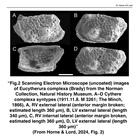RAS taxon details
Eucytherura Müller, 1894
127611 (urn:lsid:marinespecies.org:taxname:127611)
accepted
Genus
marine, brackish, fresh, terrestrial
recent only
Müller, G. W. (1894). Die Ostrakoden des Golfes von Neapel und der angrenzenden Meeres-Abschnitte. <em>Fauna und Flora des Golfes von Neapel und der angrenzenden Meeres-Abschnitte.</em> 21:1–404., available online at https://www.biodiversitylibrary.org/page/7163051
page(s): 305 [details]
page(s): 305 [details]
Brandão, S. N.; Antonietto, L. S.; Pereira, J. S.; Pereira, S. G. G.; Sá, H. A. B.; Praxedes, R. A.; Sabater, L. M., Santos, S.G.; Karanovic, I. (2025). World Ostracoda Database. Eucytherura Müller, 1894. Accessed through: RAS (Eds.) (2025) Register of Antarctic Species at: https://ras.biodiversity.aq/aphia.php?p=taxdetails&id=127611 on 2025-09-12
RAS (Eds.) (2025). Register of Antarctic Species. Eucytherura Müller, 1894. Accessed at: https://ras.biodiversity.aq/aphia.php?p=taxdetails&id=127611 on 2025-09-12
Date
action
by
original description
Müller, G. W. (1894). Die Ostrakoden des Golfes von Neapel und der angrenzenden Meeres-Abschnitte. <em>Fauna und Flora des Golfes von Neapel und der angrenzenden Meeres-Abschnitte.</em> 21:1–404., available online at https://www.biodiversitylibrary.org/page/7163051
page(s): 305 [details]
basis of record Horne, D.J.; Bruce, A.; Whittaker, J.E. (2001). Ostracoda, <B><I>in</I></B>: Costello, M.J. <i>et al.</i> (Ed.) (2001). <i>European register of marine species: a check-list of the marine species in Europe and a bibliography of guides to their identification. Collection Patrimoines Naturels,</i> 50: pp. 244-251 (look up in IMIS) [details]
additional source Weingeist, L. (1949). The ostracode genus Eucytherura and its species from the cretaceous and tertiary of the Gulf Coast. Journal of Paleontology, 23 (4), 364-379 [details] Available for editors
redescription Horne, D. J.; Lord, A. R. (2024). The ostracod genus <i>Eucytherura</i> G.W. Müller and the '<i>Cythere complexa</i> Brady' problem. <em>Paläontologische Zeitschrift.</em> , available online at https://doi.org/10.1007/s12542-024-00684-y [details] Available for editors
subsequent type designation Alexander, C. I. (1936). Ostracoda of the genera <i>Eucythere</i>, <i>Cytherura</i>, <i>Eucytherura</i> and <i>Loxoconcha</i> from the Cretaceous of Texas. <em>Journal of Paleontology.</em> 10 (8), 639-694.
page(s): 592 [details] Available for editors
page(s): 305 [details]
basis of record Horne, D.J.; Bruce, A.; Whittaker, J.E. (2001). Ostracoda, <B><I>in</I></B>: Costello, M.J. <i>et al.</i> (Ed.) (2001). <i>European register of marine species: a check-list of the marine species in Europe and a bibliography of guides to their identification. Collection Patrimoines Naturels,</i> 50: pp. 244-251 (look up in IMIS) [details]
additional source Weingeist, L. (1949). The ostracode genus Eucytherura and its species from the cretaceous and tertiary of the Gulf Coast. Journal of Paleontology, 23 (4), 364-379 [details] Available for editors
redescription Horne, D. J.; Lord, A. R. (2024). The ostracod genus <i>Eucytherura</i> G.W. Müller and the '<i>Cythere complexa</i> Brady' problem. <em>Paläontologische Zeitschrift.</em> , available online at https://doi.org/10.1007/s12542-024-00684-y [details] Available for editors
subsequent type designation Alexander, C. I. (1936). Ostracoda of the genera <i>Eucythere</i>, <i>Cytherura</i>, <i>Eucytherura</i> and <i>Loxoconcha</i> from the Cretaceous of Texas. <em>Journal of Paleontology.</em> 10 (8), 639-694.
page(s): 592 [details] Available for editors
 Present
Present  Inaccurate
Inaccurate  Introduced: alien
Introduced: alien  Containing type locality
Containing type locality
